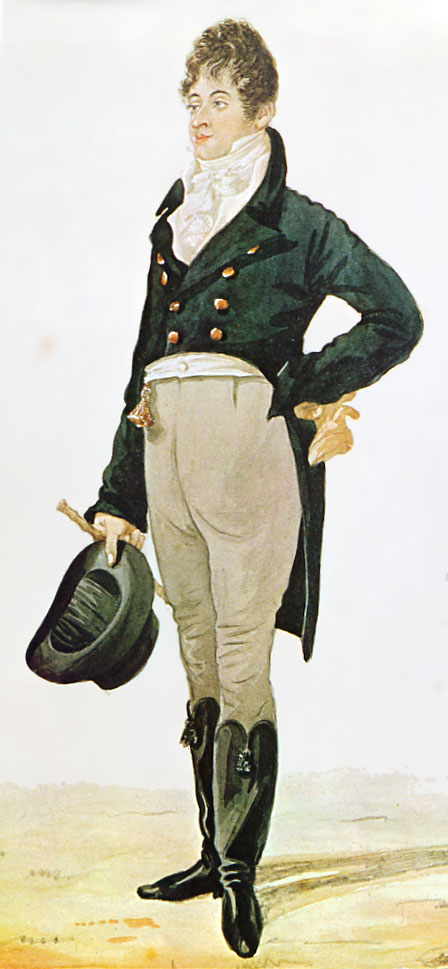Thanks for the question Katherine! I am sure you are not the only reader (or writer, for that matter) a bit confused about the different slang words for a fancy pants man.
Macaroni fashion really started in the 1760s with men returning from the Grand Tour (basically an aristocratic man’s jaunt around Europe) who started affecting European fashions meant to denote their wordliness and good taste. This was exemplified by large wigs, slim lines on their attire, and generally a more fussy attendance to appearance and fashion (http://www.atlasobscura.com/articles/the-macaroni-in-yankee-doodle-is-not-what-you-think). The term macaroni came from the small tricorn hat placed atop the outlandish wigs (http://www.homohistory.com/2012/10/our-flamboyant-forefathers-macaroni-and.html).
As this trend picked up steam over the next decade, it became more and more outrageous, including striped stockings, walking sticks, and over the top wigs (http://www.atlasobscura.com/articles/the-macaroni-in-yankee-doodle-is-not-what-you-think). Many of the caricatures or cartoons will show this exaggerated era of the macaroni :

%2B18th%2Bcentury.jpg)


Macaroni’s were fops, fribbles, fibbles and coxcombs…but never call a dandy a Macaroni (http://www.independent.co.uk/arts-entertainment/historical-notes-the-undisputed-king-of-the-dandies-1185628.html). Dandies would never wear “scarlet shoes with four inch heels and diamond buckles…(and) accessories as muffs, flowers and fans” (http://www.independent.co.uk/arts-entertainment/historical-notes-the-undisputed-king-of-the-dandies-1185628.html).

A Dandy was not only a man of fashion, but also charming and witty (The Greenwood Encyclopedia of Clothing Through World History, 2008). Neckclothes were the primary vanity, with a variety of styles and complicated knots denoting the relative skill and care of the dandy.
As opposed to over the top styles, colorful or flamboyant prints, or mincing manners, the dandy was a subdued, carefully curated look. Favoring “impeccably tailored coats and the finest linen shirts” the original dandy, Beau Brummel was also credited with popularizing “buckskin breeches, very tight trousers, and a shorter-crowned beaver hat” (The Greenwood Encyclopedia of Clothing Through World History, 2008, p. 31)
The term dandy came into fashion in 1813 and revered a “studied masculinity” that favored dark colors, no perfume but well cleaned clothes and boots, and accessories like snuff boxes that were artfully handled (http://www.dandyism.net/beau-brummell/). Dandies were also fastidiously clean themselves (http://www.history.com/news/history-lists/4-rules-for-bathing-according-to-beau-brummell).
These were not only men of fashion, but men who displayed “self-discipline” that appeared “sardonic, aloof, independent” and who were not interested in politics, attracting a mate, or following fashion (Dandy: Peacock or Engima?, 2012).
A Pink of the Ton (or Pink of Fashion) is defined by the 1811 Dictionary of the Vulgar Tongue as being “the top of the mode.” In other words, the height of fashion. A Pink is always a dandy, but a dandy isn’t always a pink.
Tulips were used almost interchangeably with Pinks, although tulips did not necessarily have to be the height of fashion, and usually just meant a well dressed man (https://www.janeausten.co.uk/bucks-beaus-dandies/). Many dandies were mocked using the terms Pink or “veritable tulip”, so it wasn’t necessarily a compliment to call a gent that (http://www.independent.co.uk/arts-entertainment/historical-notes-the-undisputed-king-of-the-dandies-1185628.html)
A buck was usually “of the first head” and a man who pursued pleasure, surpassed friends in debauchery, and was generally a blood or sporting type (https://www.janeausten.co.uk/bucks-beaus-dandies/).
A beau was a man with presence, and often vain, good looking, and a notable fashion icon (https://www.janeausten.co.uk/bucks-beaus-dandies/). Beau was often combined with other words to describe particular types of fops (like beau-nasties, or dirty fops, or crusty-beaus who caked on the makeup).
The Bond Street Beau was a well dressed man who liked to shop in and around Bond Street, but in particularly liked to go on the stroll on Bond Street; “Bond Street, at its axis, became a place not just to shop for the latest fashions, but to meet, swagger, see and be seen” (http://www.telegraph.co.uk/luxury/jewellery/harry-winston-bond-street/beau-brummell-and-store-history/)
Exquisite was a man excessively concerned about appearance, clothes, and grooming. Usually synonymous with dandy or coxcomb. Typically negative connotations, often satired, about a man being fussy or effeminate (https://janeaustensworld.wordpress.com/2012/05/22/the-distinctions-of-the-regency-dandy/)
Corinthians were athletes, sportsmen who excelled in most sporting activities of the day including fencing, boxing, hunting, shooting, driving and riding in addition to be always well dressed and mannered gentlemen (https://www.janeausten.co.uk/bucks-beaus-dandies/). Their greatest distinction from dandies or others would be their success with sport and driving (https://janeaustenslondon.com/tag/regency-slang/).
A blade was usually a dashing younger man of fashion, meant to imply youth and maybe a bit of immaturity or impetuousness.
The Nonesuch or Nonpareil was the male exquivalent of the Incomparable. Excelling at most things, including sports, driving, and the cut of his jib, he was a man to be aped (https://www.janeausten.co.uk/bucks-beaus-dandies/).
I hope that helps! As you can see, many of the differences are nuanced and there isn’t universal agreement on some of the definitions. I encourage everyone to explore the many links and learn more!









